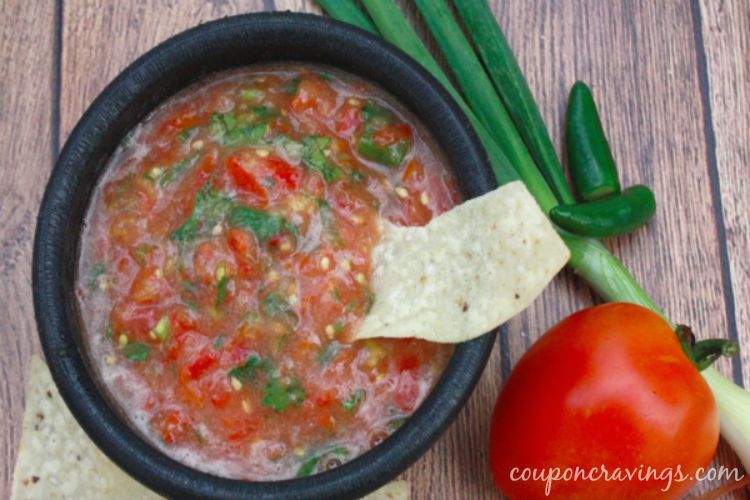Table of Content
Along with the canning items above, you’ll also need a canner, which is a large pot big enough to fill with water and jars. I used my stock pot, the same one I use to make stock or boil spaghetti –yes, that one. It would need to process at 6 pounds of pressure for 20 minutes for pint jars. Now use a canning funnel so you don’t get salsa all over the rims of your jars and fill the hot jars leaving a 1/2 inch headspace.
For a milder salsa, seed 1-2 of the jalapeños before chopping. For very mild salsa, seed all of the jalapeños. Remember that the heat will lessen as the salsa sits, so I tend to error on being spicy then not.
How Do I Make a Smooth Salsa?
I'll definitely use this recipe again and have already passed it on to my friends. Add the corn starch liquid to the big pot of salsa, stirring while pouring. Mix together the cornstarch and warm water in a small bowl.

When complete, turn off the heat and allow jars to sit in hot water for 5 minutes. Make sure the water covers each jar by 1 to 2 inches and bring it to a rolling boil over medium-high heat for 15 minutes. First things first, place the jars in a large pot of simmering water. This will prevent them from bursting when filled with hot food. First, you can boil the tomatoes until the skin becomes tender enough. You remove them from the pot, set them aside until they cool down enough to handle, and remove the skins.
Fresh Homemade Salsa
Once again, the combination of time and temperature destroys bacteria and creates a tight vacuum seal, so food stays fresh longer. This form of canning uses high temperatures to safely preserve foods that are low in acid such as meat, poultry, vegetables, chili, and seafood. The ones I used in this post are made by Ball, which has been making the most popular jars for canning since 1880. Once you’ve removed them from the water with the tongs and set aside onto a flat surface. Leave the jars undisturbed for 12 to 24 hours. Gently tap the bottom of the jar on a flat surface to remove any air bubbles; this will keep the salsa from spoiling due to trapped air.

Prepare your canner, jars, and lids, as we talk about in our intro to canning post. With how much salsa we plow through in a year, it’s a good thing that canning salsa is stupendously easy to do. Before the end of summer, I like to have at least three dozen pints of my go-to salsa stashed away in our pantry. Canning salsa is a wonderful beginner canning project, and we’re going to show you everything you need to know to have your own stockpile of salsa. After you've eaten your salsa, the jars and bands can be reused in future canning projects. However, you should never reuse lids - always purchase new lids to ensure a proper seal.
How to Can: Homemade Salsa
In the event that some of your jars do not seal properly, you can reprocess them. To do so, remove the band and lid and empty your salsa into a saucepot. Reheat them by bringing them up to a boil, then ladle them into a clean, hot jar as before. Place a new, hot lid on the jar (make sure you wipe the rim off!), hand-tighten the band, and process them again for the full fifteen minutes. Fill your large saucepot with water and bring it to a boil. Then place a few tomatoes in the water at a time.
Transfer peeled tomatoes and liquid to a large bowl. Crush tomatoes into small chunks using your hands or a whisk. Paste tomatoes are also ideal when making homemade canned tomato sauce. I wish I could invite all of you over to my house so you could have a bite of this homemade salsa for canning. It might be one of the best things that’s ever come out of my kitchen. Add onion, peppers, and cilantro.
Most salsa recipes are a mixture of low-acid foods like onions and peppers, and acid foods such as tomatoes or fruit. It's recommended to follow a USDA tested recipe if you'd like to preserve salsa rather than experiment with your own homemade recipe. The proportions of the tomatoes, peppers, herbs and other vegetables will determine which method of canning should be used. If the final pH of the salsa is less than 4.6, then the boiling water canning method can be used.
Make sure you lift the jars straight up out of the canner. The jars haven’t sealed yet, so if you tilt the jars they will leak and you might not get a seal. Don’t forget to adjust your processing time according to the altitude adjustment chart. Carefully put the closed jars into your waterbath canner.
Ladle into prepared jars, remove air bubbles, wipe the rims of the jars, and then fit with lids and rings. We cover how to do this extensively in our post on canning diced tomatoes. If it's thicker than you'd like, thin it out with the juice we squeezed out earlier.
Remove from heat and allow to sit in hot water for 5 minutes. Place the tomatoes onto 2 large baking sheets and roast for 20 to 25 minutes until the tomatoes are charred and the skins peel back. Remove from oven and allow to cool down to room temperature. Once the tomatoes are roasted, remove the skins and give them a rough chop. In the end, whatever is in season will make prime salsa and sauces. Today, I’m going to show you how to can salsa at home with a simple and easy-to-follow canning process.
Just refrigerate overnight and reheat when you’re ready to can. I haven't tried it personally but you could as long as the ACV was least 5% acidity. Just be aware it could alter the flavor a bit.

Paste tomatoes are more fleshy and therefore contain less juice and fewer seeds than other types of tomatoes, which makes them perfect for salsa. Throw the canned tomatoes, juice and all, into the bowl of a food processor. Consider freezing, rather than canning. Freezing will protect garden-fresh flavors and reduce the risks of foodborne illness. Freezing also allows flexibility – and creativity – in preparing your salsa recipe. Homemade salsa can typically be frozen for up to 12 months.

No comments:
Post a Comment